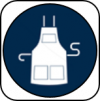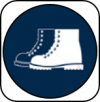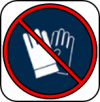Table of Contents
Bandsaw Safe Operating Procedure
Rev. August 2020
Location
The Rikon 14” bandsaw with StriaTech variable speed motor is located in 2448 Elings.
Safety Concerns
Serious injury and potential dismemberment can occur from contact with the moving saw blade.
Eye injuries can result from flying chips or broken bits. Cuts can occur from contacting sharp
tools or exposed chips and burrs. Burns can result from hot cutting tools or parts. Metal splinters
can result from exposed burrs or chips. Serious injury can result from pinching or entanglement
in moving parts. Poor housekeeping creates tripping and cutting hazards for other users. Do not
leave machine running unattended.





Eye protection, closed toe shoes, long pants, and protective clothing must be worn when using
this machine to prevent injury. Long hair must be tied back and jewelry must be removed before
operating this machine to prevent entanglement.
Training
Training Requiemnts:
Take and pass the Machine Shop Safety test found on the ME Labs GauchoSpace page, read the Drill Press document on the Innovation Workshop GauchoSpace page, attend the Innovation Workshop general machine tool training, and the Innovation Workshop Bandsaw specific training before using this machine. Additional documents found on the GauchoSpace page.
Training Outline:
- Bandsaw System Overview
- Bandsaw, Motor Controller Unit
- Exhaust System
- Supplies, Storage
- Safety
- Materials: ferrous metals, non-ferrous metals, wood, and plastic can be cut on this saw. If you have questions about a new material, please email the material in question to bothman@ucsb.edu
- Blade: Keep fingers at least 3” away from the saw blade at all times. Lower the cover to 1/4” above the workpiece to minimize risk of injury.
- Exhaust: Use the exhaust system to prevent inhalation of dust and particulates. Use brushes and the shop vacuum to clean up residual chips and dust.
- Call 911 (or 9-911 from a campus phone) if serious injury occurs. First aid supplies are located near the sink in 2448 Elings.
- Mechanical Overview
- Moving and locking the saw blade cover guard.
- Tensioning the saw blade.
- Using the rip fence.
- Tilting the cutting table.
- Adjusting the saw blade for hard materials.
- Variable Speed Motor control walkthrough
- Picking a material group.
- Selecting a material type preset
- Manually setting a blade speed.
- Exhaust System Walkthrough
- Location of exhaust unit and cleaning supplies
- Demonstrate a cut
Safety
Physical:
- The saw blade can cause serious injury and dismemberment.
- Keep fingers at least 3 inches away from the saw blades at all times.
- Keep the saw blade cover no more than a 1/4” above the surface of the stock to minimize exposure to injury
- Exercise caution when cutting large stock. Have ample clearance area.
- Keep work area clean. A cluttered work area presents multiple hazards
- The machine is kept locked until the online reservation system can be implemented. The lab staff will keep it unlocked during the workday and can unlock upon request if needed.
- Use the exhaust system and the shop vacuum to prevent inhalation of particulates.
Safe Operating Procedure
Sequence of Operation:
- Move the saw out from the alcove if cutting large stocks.
- Adjust the rip fence to the proper length for the cut. Lock the rip fence in place.
- Adjust the saw blade cover to 1/4” above the workpiece. Tighten the blade cover in place.
- Power on the motor controller. The power switch is located on the side of the unit.
- Select the proper material setting on the motor controller. Press once to select the material group and then press the button to cycle through to the appropriate settings.
- Press On to start the bandsaw.
- Turn the exhaust system on.
- Hold the material securely, keeping fingers at least 3 inches away from the saw blade. Use the push stick if necessary.
- Push the material through the saw blade evenly and slowly. If the sawblade chatters or screams, ease on the feed pressure.
- Once the cut is complete, press Off on the motor controller to stop the bandsaw. Do not reach for the parts at this time.Turn the exhaust system off as well.
- Once the saw blade has come to a complete stop, remove your parts. Use a brush or the shop vacuum to clean up any remaining dust.
- Extend the saw blade cover to cover the entire blade.
- Power off the motor controller (The motor controller stays illuminated for approximately 15 seconds after switching the power off).
- Return the bandsaw to the alcove. Clean up any remaining dust on the floor.
Detailed Procedure:
Supplies:
- Bandsaw blades are kept in the cabinet of the Bandsaw stand. Notify the lab staff by emailing bothman@ucsb.edu if you break a bandsaw blade. The lab staff will replace it.
- Resaw bar assembly is kept in the cabinet of the bandsaw stand. Use this to prevent the bandsaw blade from walking and moving during the cut.
Recommended blade selection and speed
In general, we want at least three cutting teeth to be in contact with the material being cut. So thinner materials require a finer tooth blade than thick materials. Please see lab staff for instruction on changing blades.
The bandsaw motor connects to the blade drive via a two speed belt drive. The belt must be in the low range for cutting stainless steel and titanium. All other materials may be cut with the belt in high range. The controller has 4 material categories pre-programmed: wood, metal, non-ferrous metals and plastic. Within each category 4 materials are programmed. These preset speeds are listed below. The speeds are listed in two units (sfm/rpm): surface feet per minute (sfm)/ and revolutions per minute (rpm). The conversion factor between sfm and rpm changes with the position of the belt on the drive pulley.
The speed adjust dial on the controller is used to adjust the speed up and down from these preset levels. If the saw is making a lot of noise, try lowering the speed.
References
Manuals:
Other SOP’s:
Sources for Supplies:
Contact Information:
Recipes:
General rule of thumb for TPI: always at a minimum have 3 teeth worth of engagement in your material at a time.
| Material | Blade TPI | SFPM |
|---|---|---|
| Aluminum | 24 TPI @ 1 mm, <10 TPI @ > 6 mm | 1000 FPM |
| Steel (low carbon) | 20 TPI @ 3 mm, <14 TPI @ > 6.5 mm | <250 FPM |
| Steel (stainless/Chromoly/High carbon) | 28 TPI @ 1 mm, <14 TPI @ > 6 mm | <125 FPM |
| Plastic | 24 TPI @ 1 mm, <10 TPI @ > 6 mm | 2500 FPM |
| Wood | 24 TPI @ 1 mm, <10 TPI @ > 6 mm | 4000 FPM |
Other References:
